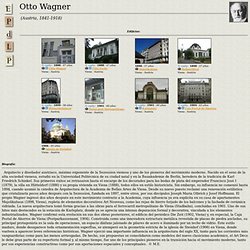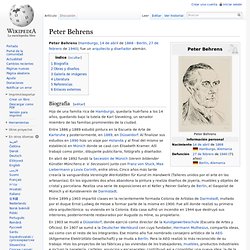

Fondation Le Corbusier. Recevez régulièrement par courriel les dernières nouvelles de la Fondation Le Corbusier Plan du site Maison La Roche Appartement-Atelier Villa Le Lac Maison Jeanneret Activités culturelles Divers Acquisitions Expositions Oeuvre Construit Rencontres Architecture Réalisations. Mies van der Rohe Society. Walter Gropius. Walter Adolph Georg Gropius (May 18, 1883 – July 5, 1969) was a German architect and founder of the Bauhaus School,[1] who, along with Ludwig Mies van der Rohe, Le Corbusier and Frank Lloyd Wright, is widely regarded as one of the pioneering masters of modern architecture.

Early life[edit] Born in Berlin, Walter Gropius was the third child of Walter Adolph Gropius and Manon Auguste Pauline Scharnweber (1855-1933). Early career (1908–1914)[edit] Walter Gropius, like his father and his great-uncle Martin Gropius before him, became an architect. Gropius could not draw, and was dependent on collaborators and partner-interpreters throughout his career. In 1913, Gropius published an article about "The Development of Industrial Buildings," which included about a dozen photographs of factories and grain elevators in North America.
Frank Lloyd Wright Foundation. Alvar Aalto MUSEO. Erik Gunnar Asplund -1885 – 1940. This is a brief presentation about the EGA-foundation Gunnar Asplund is considered as one of the leading architects in Scandinavia during the 20th century.

His influence is felt even today. During the 1980’s reevaluation of the modernism-movement, Asplunds architecture with its distinctive merging of classicism and modernism would play a significant part even at an international level. Among Asplunds most famous early works, such as the Snellman Villa (Villa Snellman), the Lister county courthouse (Listers härads tingshus), and the small chapel at the woodland cemetery (skogskapellet). The Scandia-theater in Stockholm should also be regarded as a part of these, as well as the Stockholm city-library. All where created during the period of 1918-1928. The buildings mentioned here makes up the decisive highlights of the Swedish neoclassicism which may be the most professional era of Swedish architecture. Background Asplund conducted more than forty construction and design projects.
Adolf Loos. Adolf Loos (Brno, Moravia 1870 - Viena 1933) fue un arquitecto austriaco.

Cursó estudios en la Escuela Profesional de Reichenberg y en la Politécnica de Dresden. En la ciudad de Chicago trabajó como albañil, entarimador y delineante. Posteriormente realizó obras en diversos países de Europa, tales como Austria, Francia y en Viena comienza a ejercer como arquitecto municipal, trabajando en el Ministerio de Vivienda. Vida[editar] Nació en 1870 en Brno, Moravia.
En 1899 revolucionó la arquitectura vienesa con la construcción del Café Museum. Como el ornamento ya no está unido orgánicamente a nuestra cultura, tampoco es ya la expresión de ésta. Al finalizar la I Guerra Mundial, el primer presidente de Checoslovaquia, Tomáš Masaryk, le concedió la nacionalidad checa. En 1918 se le diagnosticó cáncer. A los cincuenta años protagonizó un escándalo de pedofilia, y a los 62 estaba en la ruina.[2] Periodo arquitectónico[editar]
Otto Wagner. Otto Wagner (Austria, 1841-1918) Edificios: Biografía: Arquitecto y diseñador austriaco, máximo exponente de la Sezession vienesa y uno de los pioneros del movimiento moderno.

Nacido en el seno de la alta sociedad vienesa, estudió en la Universidad Politécnica de su ciudad natal y en la Bauakademie de Berlín, heredera de la tradición de Karl Friedrich Schinkel. Windows Media Player | Libreto (Historia y Personajes) | Aumentar | Fotos Interiores. Mackintosh. Peter Behrens. Peter Behrens (Hamburgo, 14 de abril de 1868 - Berlín, 27 de febrero de 1940), fue un arquitecto y diseñador alemán.

Biografía[editar] Hijo de una familia rica de Hamburgo, quedaría huérfano a los 14 años, quedando bajo la tutela de Karl Sieveking, un senador miembro de las familias prominentes de la ciudad. Entre 1886 y 1889 estudió pintura en la Escuela de Arte de Karlsruhe y posteriormente, en 1889, en Düsseldorf. Al finalizar sus estudios en 1890 hizo un viaje por Holanda y al final del mismo se estableció en Múnich donde se casó con Elisabeth Kramer.
Allí trabajó como pintor, dibujante publicitario, fotógrafo y diseñador. En abril de 1892 fundó la Secesión de Múnich (Verein bildender Künstler Münchens e. Entre 1899 y 1903 impartió clases en la recientemente formada Colonia de Artistas de Darmstadt, invitado por el duque Ernst Ludwig de Hesse a formar parte de la misma en 1900. Obras y diseños[editar] 1909, AEG Turbinenhalle o Nave de turbinas de la empresa AEG, Berlín.